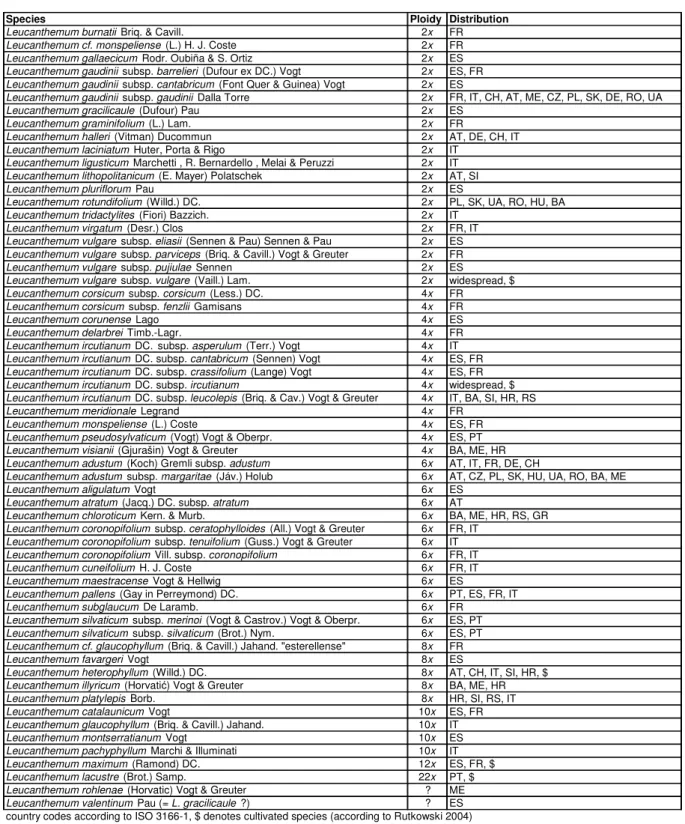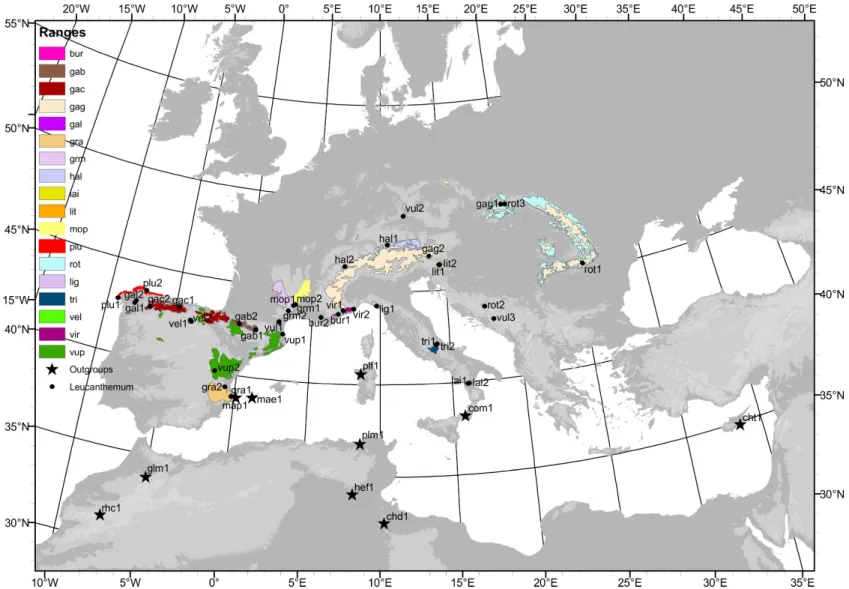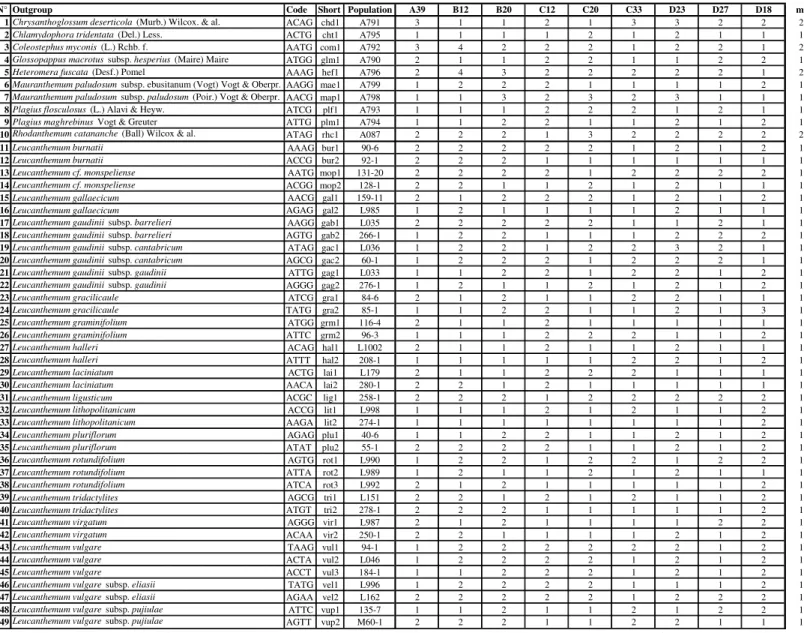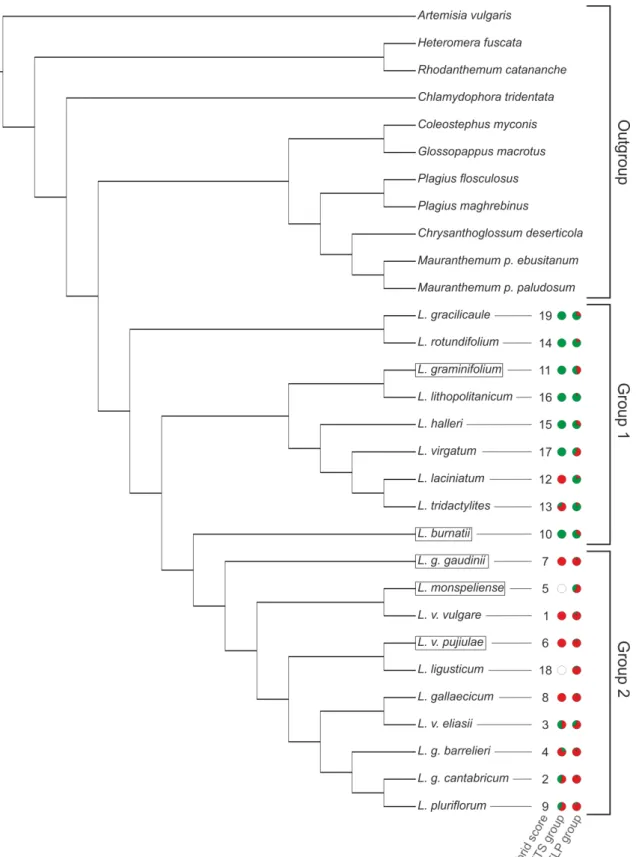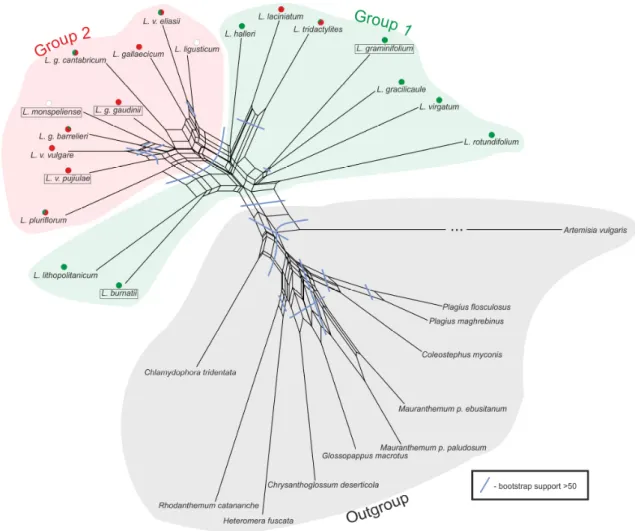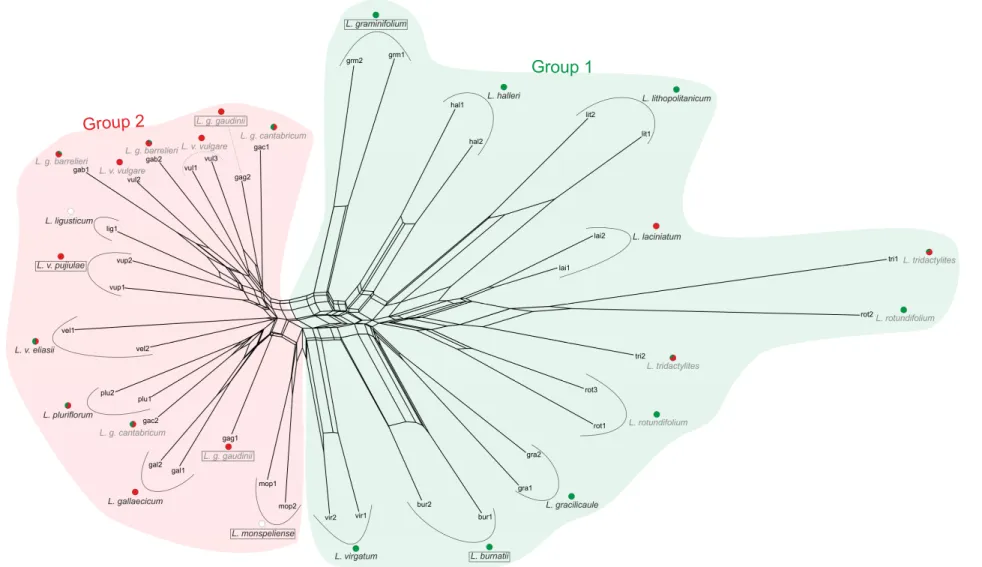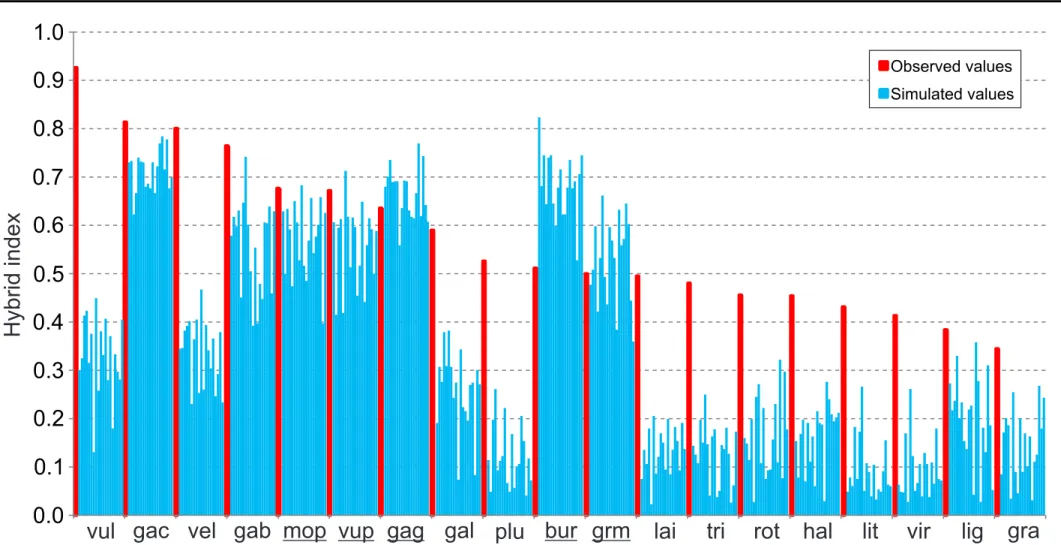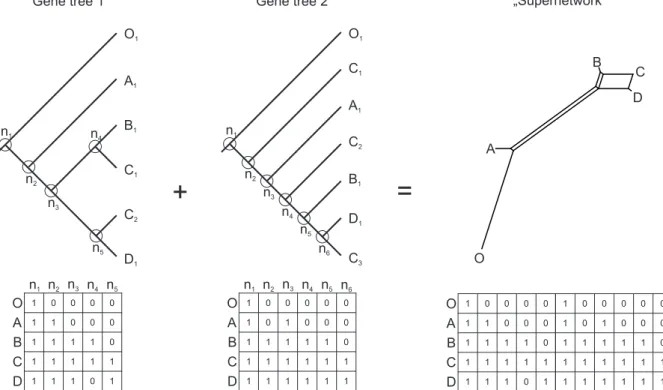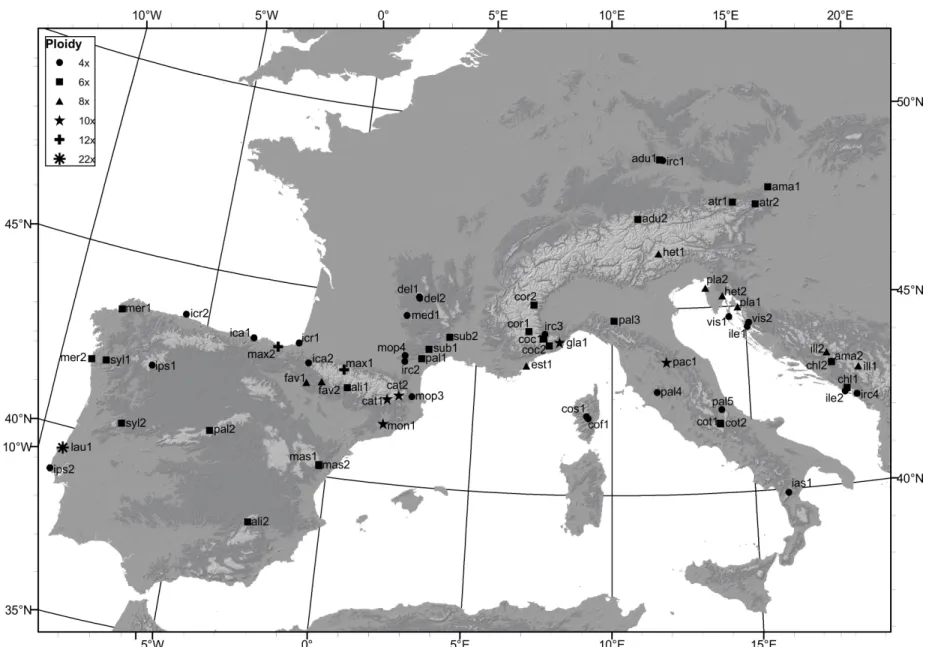polyploid complex of Leucanthemum Mill.
(Compositae, Anthemideae)
DISSERTATION ZUR ERLANGUNG DES DOKTORGRADES DER NATURWISSENSCHAFTEN (DR. RER. NAT.)
DER FAKULTÄT FÜR BIOLOGIE UND VORKLINISCHE MEDIZIN DER UNIVERSITAT REGENSBURG
vorgelegt von Kamil Konowalik
aus
Brzeg Dolny, Polen im Jahr
2014
Das Promotiongesuch wurde eingereicht am: 26.05.2014
Die Arbeit wurde angeleitet von:
Prof. Dr. Christoph Oberprieler
Unterschrift:
I would like to dedicate that work to Agnieszka, Dobromiła and Radomir.
TABLE OF CONTENTS
TABLE OF CONTENTS ...I
1. GENERAL INTRODUCTION ... 1
1.1. PHYLOGENETIC RECONSTRUCTION... 1
1.2. HYBRIDIZATION AND HOMOPLOID HYBRID SPECIATION... 3
1.3. POLYPLOIDY... 4
1.4. LEUCANTHEMINEAE AND LEUCANTHEMUM... 5
1.5. THESIS OUTLINE... 7
2. CHAPTER 1 ... 9
PHYLOGENY OF DIPLOID LEUCANTHEMUM MILL. (COMPOSITAE , ANTHEMIDEAE) ... 9
2.1. ABSTRACT:... 10
2.2. INTRODUCTION... 10
2.3. MATERIAL AND METHODS... 14
2.4. RESULTS... 29
2.5. DISCUSSION... 52
3. CHAPTER 2 ... 59
PHYLOGENETIC PATTERNS IN LEUCANTHEMUM MILL. (COMPOSITAE, ANTHEMIDEAE) ... 59
3.1. ABSTRACT:... 60
3.2. INTRODUCTION... 60
3.3. MATERIAL AND METHODS... 64
3.4. RESULTS... 82
3.5. DISCUSSION... 90
4. CHAPTER 3 ... 99
PUZZLING PHYLOGEOGRAPHY OF HIGH POLYPLOID LEUCANTHEMUM GLAUCOPHYLLUM (COMPOSITAE, ANTHEMIDEAE) AND CLOSELY RELATED TAXA – INCLUDING RESULTS FROM FLOW CYTOMETRY, AFLP AND 454 SEQUENCING ... 99
4.1. ABSTRACT:... 100
4.2. INTRODUCTION... 100
4.3. MATERIALS AND METHODS... 105
4.4. RESULTS... 111
4.5. DISCUSSION... 119
5. GENERAL CONCLUSIONS... 126
6. SUMMARY ... 131
7. REFERENCES ... 132
8. APPENDIX A ... 154
8.1. GENE TREES FOR DIPLOIDS... 154
9. APPENDIX B ... 165
9.1. GENE TREES FOR POLYPLOIDS... 165
10. APPENDIX C ... 193
11. APPENDIX D ... 202
11.1. PROTOCOL OF DATA ANALYSIS FOR 454 SEQUENCING... 202
12. APPENDIX E... 207
12.1. PROTOCOL FOR FLOW CYTOMETRY MEASUREMENT... 207
13. ACKNOWLEDGMENTS... 210
1. G
ENERAL INTRODUCTION 1.1. Phylogenetic reconstructionPhylogeny forms the hypotheses about the origin and relationships among species and tries to improve our understanding of evolution. Its history dates back to times of ancient philosophers but prominent development was reached after works of Darwin and Haeckel in XIX century. They laid the foundation of modern phylogeny by developing the theory of evolution (Darwin 1859) and principles regarding the representation of phylogeny on a phylogenetic tree (Haeckel 1866). Around the beginning and middle of XX century a new branch of phylogenetics appeared which transformed systematic biology – molecular phylogenetics. Initially it used information gained from sources such as serology (e.g. Nuttall 1902), chromatography (e.g. Pearson 1967) or electrophoresis of proteins (e.g.
McCabe & Deutsch 1952). After the major breakthrough in molecular biology which was the discovery of the structure of DNA (Watson & Crick 1953) it started to develop very quickly and assimilated methods associated with nucleic acids. Firstly methods associated with DNA-DNA hybridization were dominating (e.g. De Ley et al. 1970), trough shearing of DNA with restriction enzymes, to finally reach the present stage of sequencing particular regions of DNA which will be likely exchanged with the sequencing of whole genomes in the future (Delsuc et al. 2005). Since the beginning, progress of that field was closely associated (and still is) with increasing usage of computers and development of statistical methods suited to analyze data in phylogenetic perspective – especially nucleotide sequences (Graur & Li 2000, Suárez-Díaz & Anaya-Muñoz 2008). Most widely used methods are parsimony, maximum likelihood, and Bayesian inference (Graur & Li 2000). Development of molecular phylogenetics is very important for the systematic biology because of its advantages over the classifications based only on morphological or chemical similarities. Most importantly in contrary to those, DNA sequencing can distinguish homology from analogy (Finch 1970). In its current form it presents a superior source of information regarding the relationships among organisms because it is more objective and may be used to estimate a molecular clock which is used not only to reveal the connections among organisms but also to put their evolution into a timeframe (Graur &
Li 2000, Suárez-Díaz & Anaya-Muñoz 2008, Suárez-Díaz 2009). It presents a wide range of possible uses and influences other branches of biology such as biogeography, ecology, taxonomy, and evolutionary biology – or conversely it integrates all this disciplines. Many challenging projects arose such as those which aim to reconstruct the whole tree of life using molecular phylogeny (e.g. Tree of Life Web Project www.tolweb.org, see also Wolf
et al. 2002, Puigbò et al. 2009, House 2009, Pace 2009). Also of major importance to modern botany is the molecular-based flowering plant classification (APG 1998, APG 2003, APG 2009).
Starting with the DNA sequencing, classical work on molecular phylogeny at lower taxonomic levels involved working with one or few loci, in plant biology, typically nuclear internal transcribed spacer (ITS) and external transcribed spacer (ETS) with addition of some chloroplast markers (Appels & Dvořák 1982, Yokota et al. 1989, Baldwin 1992, Baldwin et al. 1995, Baldwin & Markos 1998). Although this combination revolutionized modern plant systematics it has several drawbacks. Among them are the multicopy nature of ITS and ETS, often low phylogenetic resolution and possible overestimation/underestimation of phylogenetic signal based on a single locus (Álvarez &
Wendel 2003). Usually those traditional markers also fail to resolve relationships within evolutionary young groups which did not accumulate sufficient level of divergence, as it was the case with the genus under study (Hößl 2006). In addition, processes such as incomplete lineage sorting (ILS) and hybridization are difficult to distinguish with the usage of those markers.
The discordance between gene trees and species trees has been noticed already some time ago (e.g. Fitch 1970, Pamilo & Nei 1988). Still one has to agree that until recently, most of the phylogenies reconstructed gene trees rather than species trees, and claimed that gene tree represents the tree of species relationships (Degnan & Rosenberg 2009). The discordance between those two types of trees arises mainly because incomplete lineage sorting (ILS) which is a “failure of two or more lineages in a population to coalesce” (Degnan & Rosenberg 2009). To overcome those problems and transit from the gene tree reconstruction to the species tree reconstruction more than one locus is required.
Ideal for that purpose are so called single-copy genes (sometimes referred as low-copy genes) distributed across the genome in orthologous positions. Incorporating them into phylogeny requires usage of new methods analyzing and summarizing trees obtained from multiple markers instead of examining single gene trees or trees based on concatenated data (Kubatko & Degnan 2007, Degnan & Rosenberg 2009). The species tree reconstruction furthermore needs to incorporate simultaneously incomplete lineage sorting among different genes as well as other processes causing incongruence among the gene trees. With regard to the plant biology, the most prominent processes may be hybridization and polyploidy. Hybridization has similar effects on phylogeny as ILS. It causes incongruence among gene trees by combining alleles in a way that some of them may be exchanged between distantly related species which induce the relationships that may not
fully represent the true/complete phylogeny (e.g. especially when there is one allele or an allele is missing). In the same manner as ILS, presence of hybridization in the dataset affects also the relationships between gene trees and species tree implying a network-like structure for the latter. Some approaches have been proposed to distinguish both processes (cf. Chapter 1). The second process of polyploidization complicates those relationships even further by duplication of loci leading to the situation that they eventually became paralologous. Hybridization and polyploidy, due to the frequent occurrence in Leucanthemum, are within main focus of this thesis.
1.2. Hybridization and homoploid hybrid speciation
Hybridization is an interbreeding of two genetically distinct individuals which produces progeny possessing a combination of heritable characteristics derived from both parents (Allendorf et al. 2001). Intermediacy between parents is present in the genome constitution and typically may be also observed on inherited traits. However, hybrids often have some novel features which are not present in the parents (sometimes observed as a hybrid vigor/heterosis) and may originate by processes such as for example novel gene expression patterns (e.g. Chelaifa et al. 2010). Hybridization may occur repeatedly especially in sympatric zones between two species or may occur by chance and very rarely with occasional migrants. Furthermore hybrids are either infertile, or fertile, which is decisive on their future and establishment. Another feature of hybrids in a polyploid complex is that they may be intermediate between two ploidies or retain ploidy level of the parents. In case when the ploidy level is maintained homoploid hybrid speciation may take place (typically this term is applied only to the hybrids on the diploid level). It is a variant of hybridization where after crossing of two taxa, their hybrid speciate into a new form and become isolated from their parental species to ultimately form a new taxon (Stebbins 1950, Grant 1971, Rieseberg 1997, Rieseberg & Willis 2007). This kind of hybridization requires that taxa are not so distant from each other because otherwise the difficulties in producing hybrid and problems with fertility increase (Buggs et al. 2008). The isolation from parental species can be achieved after several generations (cf. Grant 1966) or by spatial isolation (Buerkle et al. 2000). Incidence of homoploid hybrid speciation in the genus Leucanthemum has been suggested by Oberprieler et al. (2014) who found that majority of diploid species contained one of the two major ETS ribotypes while some species contained a mixture of both ribotypes (L. pluriflorum, L. gaudinii subsp. cantabricum, L.
gaudinii subsp. barrelieri, L. vulgare subsp. eliasii, L. tridactylites). The authors
considered taxa which possessed two ribotypes as having putative hybridogenous origin (Oberprieler et al. 2014, Appendix B). Mainly because of this recent finding homoploid hybrid speciation within the genus Leucanthemum became one of the main focus of Chapter 1.
1.3. Polyploidy
Since the first mention of polyploidy by Strasburger (Strasburger 1910) and its definition (Winkler 1916), points of view considering the importance of this process changed. Hugo de Vries saw polyploidy as mutation leading to formation of new forms (de Vries, 1901).
In more recent times probably most influential works came from Stebbins (e.g. Stebbins 1971, Stebbins 1985) which considered polyploidy itself to be a stabilizing and conservative evolutionary process. Besides points of view considering significance of this process, various studies estimated polyploidy frequency to account for 30% to 80% of current angiosperm species (reviewed in Soltis et al. 2009). With the discovery of multiple polyploidizations during evolution of all angiosperm lineages (Soltis et al. 2009, Jiao et al.
2011), polyploidy significance raised together with general interest in this phenomenon.
While it may be responsible for the diversification of the whole families, in certain lineages it also plays an important role as a mode of speciation (Wood et al. 2009). In particular, it is very frequent within the Compositae family where numerous polyploid species are established and plants up to octotetracontaploid (48x) level are found (Semple
& Watanabe, 2009). Commonness of this process especially in the plant kingdom highlights its importance and impact on evolution. But it is not only specific to plants – it is frequent in other organismal groups such as fungi or animals (Van de Peer et al. 2009, Albertin & Marullo 2012). Nowadays it is accepted that all major groups of vascular plants have gone through polyploid events at least once and in some families as in Compositae even more often during their evolutionary history (Soltis et al. 2009, Van de Peer et al.
2009). Many polyploid complexes were subjects of phylogenetic research and examples include: Achillea (Guo et al. 2004, Guo et al. 2005), Silene (Popp et al. 2005, Popp &
Oxelman 2007), Viola (Marcussen et al. 2012), Artemisia (Pellicer et al. 2010, Garcia et al.
2011, Richardson et al. 2012), and Melampodium (Blöch et al. 2009, Rebernig et al. 2010).
As majority of Leucanthemum taxa is polyploidy, it became focus of Chapter 2 which deals with phylogeny of polyploids, and Chapter 3 which gives insights into more specific question considering L. glaucophyllum and related taxa.
1.4. Leucanthemineae and Leucanthemum
All Leucanthemum taxa are perennial herbs with variable leaf morphology (entire, serrate, pinnatifid), alternate leaves, solitary or laxly corymbose capitula, receptacle convex or conical, without receptacular bracts (epaleate), white female ray florets (sometimes absent), disc corolla 5-lobed, ca. 10-ribbed cypselas with myxogenic cells and vascular strands between the ribs, possessing auriculate corona-like pappus (sometimes absent) (Bremer & Humphries 1993, Oberprieler et al. 2006). Its specific feature are anthocyanin red root tips, which are characteristic for that genus (Bremer & Humphries 1993). As treated in Euro+Med PlantBase (2006) and Oberprieler et al. (2009), Leucanthemum constitutes a morphologically homogenous genus.
The subtribe Leucanthemineae belongs to the Mediterranean clade of Eurasian grade of tribe Anthemideae and family Compositae (Oberprieler et al. 2009). The subtribe consists of eight genera and ca. 69 species, majority of which is concentrated within the genus Leucanthemum consisting of around 41 species (56 species and subspecies) (Table 1) while the other genera typically consist of one or few species. All unispecific Leucanthemineae genera also have somehow restricted endemic distributions in southern part of the Mediterranean basin (North Africa, Cyprus) in some cases also reaching similar regions in its northern part (southern Iberian Peninsula, southern Apennine Peninsula, Mediterranean islands; Oberprieler et al. 2009). Leucanthemum does not reach this part having its center of distribution rather in cooler regions of northern Mediterranean including the central and northern Iberian Peninsula, the Alps, the Apennine Peninsula, the Balkan Peninsula and reaching further north and east (Vogt 1991, Euro+Med PlantBase, 2006). Also noticeably most of the unispecific genera from southern taxa are diploids with hybrids being present but almost without records of polyploidy (Wilcox 1982, Oberprieler et al. 2011). In the northern lineage of Leucanthemineae i.e. Leucanthemum, polyploidy is a widespread phenomenon and from 41 species only 14 (19 taxa) are diploid whereas the others form the polyploid series from tetraploids (2n = 4x = 36) to dokosaploid (2n = 22x = 198). 19 diploid taxa distributed across the whole range of the genus have well defined distributions associated with their habitat requirements but in some cases they also overlap sympatrically. It has been shown that these ranges and overlaps changed significantly during the last ice ages leading undoubtedly to contact of some species which are separated today (Oberprieler et al. 2014, Appendix B). It has been also shown that some Iberian Leucanthemum taxa had even wider ranges during last glacial maximum compared with their present distribution (Oberprieler et al. 2014, Appendix B).
Leucanthemum represents an interesting model for studying polyploidy and hybridization but as illustrated in the various works done previously, relationships among taxa seem to be rather complex and often hard to resolve. This complexity partially originates from taxonomic classification and as noted by Pearson (1967): “survey of taxonomic literature on this species aggregate reveals that there is widespread confusion resulting from regional authors having created superfluous synonyms and giving inadequate plant descriptions” (Pearson 1967, p.92). In this thesis this problem is circumvented by usage of the taxonomic concept of Vogt (1991) which treated Iberian Leucanthemum plants as different species when they were different in ploidy, distributional range, and morphology. This concept in similar form was also adapted in Euro+Med treatment (Euro+Med PlantBase, 2006) which is a taxonomical backbone for the adapted classification. Available studies indicate that species barriers in the genus are not very strong and different taxa may hybridize when brought into contact (Villard 1971, Greiner
& Oberprieler 2012). This creates a network of species relationships which needs detailed methods and sampling to resolve them. Usage of next generation sequencing coupled with low-copy nuclear and chloroplast markers seems to be a promising perspective in the investigation of polyploid origin. Inferring the origin of polyploid species represents the most difficult riddle in this complex genus but at the same time knowledge about it could be a key to understanding the evolution of this group.
Species Ploidy Distribution
Leucanthemum burnatii Briq. & Cavill. 2x FR
Leucanthemum cf. monspeliense (L.) H. J. Coste 2x FR
Leucanthemum gallaecicum Rodr. Oubiña & S. Ortiz 2x ES Leucanthemum gaudinii subsp. barrelieri (Dufour ex DC.) Vogt 2x ES, FR Leucanthemum gaudinii subsp. cantabricum (Font Quer & Guinea) Vogt 2x ES
Leucanthemum gaudinii subsp. gaudinii Dalla Torre 2x FR, IT, CH, AT, ME, CZ, PL, SK, DE, RO, UA
Leucanthemum gracilicaule (Dufour) Pau 2x ES
Leucanthemum graminifolium (L.) Lam. 2x FR
Leucanthemum halleri (Vitman) Ducommun 2x AT, DE, CH, IT
Leucanthemum laciniatum Huter, Porta & Rigo 2x IT
Leucanthemum ligusticum Marchetti , R. Bernardello , Melai & Peruzzi 2x IT Leucanthemum lithopolitanicum (E. Mayer) Polatschek 2x AT, SI
Leucanthemum pluriflorum Pau 2x ES
Leucanthemum rotundifolium (Willd.) DC. 2x PL, SK, UA, RO, HU, BA
Leucanthemum tridactylites (Fiori) Bazzich. 2x IT
Leucanthemum virgatum (Desr.) Clos 2x FR, IT
Leucanthemum vulgare subsp. eliasii (Sennen & Pau) Sennen & Pau 2x ES Leucanthemum vulgare subsp. parviceps (Briq. & Cavill.) Vogt & Greuter 2x FR
Leucanthemum vulgare subsp. pujiulae Sennen 2x ES
Leucanthemum vulgare subsp. vulgare (Vaill.) Lam. 2x widespread, $ Leucanthemum corsicum subsp. corsicum (Less.) DC. 4x FR
Leucanthemum corsicum subsp. fenzlii Gamisans 4x FR
Leucanthemum corunense Lago 4x ES
Leucanthemum delarbrei Timb.-Lagr. 4x FR
Leucanthemum ircutianum DC. subsp. asperulum (Terr.) Vogt 4x IT Leucanthemum ircutianum DC. subsp. cantabricum (Sennen) Vogt 4x ES, FR Leucanthemum ircutianum DC. subsp. crassifolium (Lange) Vogt 4x ES, FR Leucanthemum ircutianum DC. subsp. ircutianum 4x widespread, $ Leucanthemum ircutianum DC. subsp. leucolepis (Briq. & Cav.) Vogt & Greuter 4x IT, BA, SI, HR, RS
Leucanthemum meridionale Legrand 4x FR
Leucanthemum monspeliense (L.) Coste 4x ES, FR
Leucanthemum pseudosylvaticum (Vogt) Vogt & Oberpr. 4x ES, PT Leucanthemum visianii (Gjurašin) Vogt & Greuter 4x BA, ME, HR Leucanthemum adustum (Koch) Gremli subsp. adustum 6x AT, IT, FR, DE, CH
Leucanthemum adustum subsp. margaritae (Jáv.) Holub 6x AT, CZ, PL, SK, HU, UA, RO, BA, ME
Leucanthemum aligulatum Vogt 6x ES
Leucanthemum atratum (Jacq.) DC. subsp. atratum 6x AT
Leucanthemum chloroticum Kern. & Murb. 6x BA, ME, HR, RS, GR
Leucanthemum coronopifolium subsp. ceratophylloides (All.) Vogt & Greuter 6x FR, IT Leucanthemum coronopifolium subsp. tenuifolium (Guss.) Vogt & Greuter 6x IT Leucanthemum coronopifolium Vill. subsp. coronopifolium 6x FR, IT
Leucanthemum cuneifolium H. J. Coste 6x FR, IT
Leucanthemum maestracense Vogt & Hellwig 6x ES
Leucanthemum pallens (Gay in Perreymond) DC. 6x PT, ES, FR, IT
Leucanthemum subglaucum De Laramb. 6x FR
Leucanthemum silvaticum subsp. merinoi (Vogt & Castrov.) Vogt & Oberpr. 6x ES, PT Leucanthemum silvaticum subsp. silvaticum (Brot.) Nym. 6x ES, PT Leucanthemum cf. glaucophyllum (Briq. & Cavill.) Jahand. "esterellense" 8x FR
Leucanthemum favargeri Vogt 8x ES
Leucanthemum heterophyllum (Willd.) DC. 8x AT, CH, IT, SI, HR, $
Leucanthemum illyricum (Horvatić) Vogt & Greuter 8x BA, ME, HR
Leucanthemum platylepis Borb. 8x HR, SI, RS, IT
Leucanthemum catalaunicum Vogt 10x ES, FR
Leucanthemum glaucophyllum (Briq. & Cavill.) Jahand. 10x IT
Leucanthemum montserratianum Vogt 10x ES
Leucanthemum pachyphyllum Marchi & Illuminati 10x IT
Leucanthemum maximum (Ramond) DC. 12x ES, FR, $
Leucanthemum lacustre (Brot.) Samp. 22x PT, $
Leucanthemum rohlenae (Horvatic) Vogt & Greuter ? ME Leucanthemum valentinum Pau (= L. gracilicaule ?) ? ES country codes according to ISO 3166-1, $ denotes cultivated species (according to Rutkowski 2004)
Table 1 - Species and taxa of Leucanthemum Mill. according to the Euro+Med PlantBase (2006).
Country codes are according to ISO 3166-1, and $ denotes cultivated species.
1.5. Thesis outline
This thesis focuses on reconstructing the phylogeny of genus Leucanthemum which due to its intermediate size (ca. 41 species) and unbroken polyploid chain seem to be an ideal model for studying the history of polyploidy. Also as suggested by previous studies,
homoploid hybrid speciation could have played a role in the evolution of diploid species which provides the opportunity to examine that hypothesis in more detail.
The aim of Chapter 1 is to bring insights into the phylogeny of the diploids which form the foundation of the whole genus Leucanthemum. In order to establish relationships among taxa, nine low-copy nuclear genes are sequenced using 454 sequencing technology for all diploid taxa currently recognized with at least two accessions per taxon.
Additionally, five markers from the chloroplast genome are sequenced with Sanger sequencing. This provides the possibility to construct a species tree and provides basic insights into the relationship with other Leucanthemineae genera. Furthermore this chapter is especially focused on the incidence of homoploid hybrid speciation and presents a novel method to evaluate it using a simulation study.
The aim of Chapter 2 is to explore relationships among all Leucanthemum taxa with inclusion of polyploids and special focus on them. As in the previous chapter it is based on low-copy nuclear and chloroplast markers. The results are presented as supernetwork generated from gene trees coded as a 0/1 matrix. Inspite of its reduced capacity of discrimination between actual hybridization and incomplete lineage sorting, it provides insights into the evolution of the whole genus and in particular sheds light on the relationships within several more specific groups.
The aim of Chapter 3 is to clarify relationships among several taxa classified earlier as L. glaucophyllum varieties (Briquet & Cavillier 1906) and L. pallens presumably related to them. It uses previous approaches coupled with more detailed sampling on the species level and additionally includes AFLP banding patterns. This sheds light onto the phylogeography of one of the most widespread Leucanthemum taxa in the Mediterranean – the hexaploid L. pallens. Insights into this intricate group of high polyploids related to L.
glaucopyllum are presented with possible description of new species and several insights into evolution and processes occurring in the whole group and in particular taxa.
Any taxonomical novelties appearing in the present publication should not be regarded as an official statement, and have to be treated as a suggestion.
2. C
HAPTER1
Phylogeny of diploid Leucanthemum Mill. (Compositae , Anthemideae)
This chapter is designed for publication with following authorship: Kamil Konowalik, Florian Wagner, Salvatore Tomasello, Robert Vogt, Christoph Oberprieler. Author contributions are as follows: study conception and design: CO, KK, ST, FW; laboratory work: KK (AFLP: FW & KK); determination and collection of specimens: RV, CO, KK, ST; writing: KK; analysis of the data: KK, FW performed all calculations associated with hybrid index and prepared Figure 7.
2.1. Abstract:
The genus Leucanthemum Mill. is a species-rich polyploid complex of southern and central Europe, comprising ca. 41 species with ploidy levels ranging from 2x to 22x. In this chapter phylogenetic analysis of diploids is presented using species tree and network reconstructions. Previous studies have shown that some of the diploids may have originated trough homoploid hybrid speciation. In order to detect hybridization and pinpoint taxa with higher probabilities of being of hybrid origin compared to others, strategy based on the method for estimating the probability of a gene tree topology within a given phylogenetic network was used in the current study. Having inferred the species tree for 19 diploid Leucanthemum taxa and the outgroup taxa based on gene trees from nine nuclear and one plastidal loci, a “hybrid index” was calculated for each of the Leucanthemum taxa by (a) describing all possible triplet species trees, (b) pruning of gene trees to produce the corresponding triplet gene trees, (c) calculating the probabilities for hybrid vs. non-hybrid scenarios for a given triplet based on the simultaneous consideration of all ten triplet gene trees, and (d) summing up the frequency of its hybrid/non-hybrid interpretation for each diploid taxon. As a complement and to verify the results statistically, the hybrid index obtained from real data was compared to nineteen hybrid indices from simulated data which were influenced only by incomplete lineage sorting.
The results indicated that hybridization was not involved in the formation of only five taxa while the other fourteen had significantly higher real hybrid indices than simulated values.
This suggests that incomplete lineage sorting alone is not enough to explain incongruence among gene trees and that a hybridization likely played a role in the formation of these taxa. Furthermore results show that Leucanthemum diploids may be classified into two larger groups (named as ‘Group 1’ and ‘Group 2’) which are stable and found consistently by different analyses.
Keywords: ox-eye daisy, Asteraceae, homoploid hybrid speciation
2.2. Introduction
Hybridization is often stressed as one of the most important evolutionary processes.
Especially within the plant kingdom around 25% of species may hybridize (Mallet 2005).
Its exceptionality is highlighted by the rate of change induced by this process which at once merges two distinct genotypes into a novel combination. On the one hand it may be a
dead end for the species (despeciation and introgression) and on the other it may be a way to create new taxa (homoploid/polyploid hybrid speciation) (Mallet 2007, Abbott et al.
2013). Speciation via hybridization can occur in two ways – involving polyploidy and change in chromosome number or homoploid hybrid speciation where the hybrid have the same ploidy as parental taxa (Hegarty et al. 2005, Rieseberg & Willis 2007). The second process commonly thought to be less common is now attracting particular interest (Buerkle et al. 2000, Gross & Rieseberg 2005) and has been increasingly reported especially for plants(e.g. Howarth et al. 2005, James et al. 2005, Kelly et al. 2010, Peruzzi et al. 2011).
Already Grant (1966) notes that homoploid hybrid speciation is an interesting process but at the same time rare in nature. But this rarity may be associated with the difficulties to detect it (reviewed in Kelly et al. 2010). Therefore the incidence of homoploid hybrid speciation is probably largely underestimated (Seehausen 2004, Mallet 2005, Kelly et al.
2010).
Incorporating hybridization into phylogenetic reconstruction was always a point of interest for many biologists. Within single gene phylogenies it involved comparison between chloroplast and nuclear markers (typically ITS or ETS) based on gene trees incongruence (e.g. Pirie et al. 2009). Although these methods are still in use, slowly the transition from single gene to multi gene reconstructions is observable. The advantage of the latter lies in the possibility of constructing not only a gene tree but also a species tree.
However, incorporating hybridization into a species tree analysis is more challenging.
Reconstructing species history needs to use more than a single locus, and typically it is based on single- or low-copy genes which are distributed across the genome in orthologous positions. Due to reticulate evolutionary processes they are often incongruent and species tree reconstruction method needs to take this into account (Maddison 1997). Most common source of reticulation is incomplete lineage sorting (ILS) and it is already widely addressed by majority of currently available methods. But apart from ILS, further species tree reconstruction needs to simultaneously incorporate hybridization which can cause incongruence among the gene trees as well.
Unfortunately due to computational difficulties hybridization was omitted or ignored in most of the available species tree reconstruction methods (e.g. Heled &
Drummond 2010). Here attempts which tried to account for both processes, namely ILS and hybridization, are shortly reviewed. Sang and Zhong (2000) proposed a test to distinguish between hybridization and ILS based on differences in the divergence times in incongruent gene trees but their method was later criticized (Holder et al. 2001). Holland et al. (2008) used filtered supernetwork to distinguish ILS from hybridization but this
approach needed many gene trees which are congruent in large parts and in case when multiple hybridizations occurred, the phylogenetic inference was limited (Holland et al.
2008). Kelly et al. (2010) used supernetworks with combination of recombination tests and Lento plots to find hybrids. Joly et al. (2009) proposed a statistical test to detect hybridization but it relied on specified input species tree and may have failed to detect hybridization in cases when recombination was present within the dataset or when population sizes and divergence times were miscalculated (Joly et al. 2009). Kubatko (2009) developed a likelihood-based method later implemented in a software (Kubatko et al. 2009) but it was limited to one hybrid species per analysis which had to be chosen manually along with specification of the parents. Same limitation was also true for HybTree script of Gerard et al. (2011) and although both methods may be of interest in hypothesis testing, they are not suitable for computing phylogenetic trees and networks.
Method of Maureira-Butler et al. (2008) extended by Blanco-Pastor et al. (2012) uses a simulation of ILS on obtained gene trees to create tree distances which are used for selection of taxa causing strongest incompatibility between gene trees. De Villiers et al.
(2013) proposed an alternative method based on gene tree incongruence using supporting information obtained from morphology and genealogical sorting index, its main advantage lying in the possibility of detecting hybrids within coalescent stochasticity zone where ILS and hybridization signal is hard to distinguish. Significant progress has been made made continuously by L. K. Nakhleh group (CS Bioinformatics Group, Rice University, USA) who developed already several methods working with multiple alleles and multiple accessions which are typically too complex for previously mentioned attempts. All of them are also embedded in easy to use software which is continuously upgraded (Than et al.
2008, Than and Nakhleh 2009). Three currently available methods are able to infer hybridization in presence of incomplete lineage sorting. Yu et al. (2012) infers probability of parental contribution to the hybrid when hybrid and parents are already specified. Yu et al. (2013) proposed a method capable of allowing and inferring multiple hybrids in the species tree which creates then a species network based on the parsimony criteria. Sibling method but based on the maximum likelihood developed by Park & Nakhleh (2012) is also able to infer multiple hybrids within a species network. The drawback of these two methods is that they are relying on a number of reticulations suggested by the user although even this step may be optimized by usage of information criteria (AIC or BIC).
Besides those attempts incorporating hybridization into phylogenetic reconstructions is still accidental rather than an established procedure. The cause for this may be that all above methods have some limitations and typically require a lot of manual
work, expect difficult to format input files or they are computationally very intensive which prohibits larger analyses. One needs to bear in mind that ignorance of hybridization and favoring only ILS in the species tree analysis brings unreliability to phylogenetic reconstruction which is actually the case in majority of present phylogenetic studies. In fact, simulations of gene flow between species (which under some scenarios may be similar to hybridization) revealed that it may have a strong influence on accuracy of species tree reconstruction affecting correct topology, overestimating population sizes and underestimating divergence times (Leaché et al. 2013).
Processes like ILS and hybridization coupled with recent diversification were suggested to play an important role in the Mediterranean area (Blanco-Pastor et al. 2012 and references therein). In fact this region is spatially much differentiated climatically (with transitions from deserts to humid areas) and geologically (with alteration of mountains and plains). Moreover, the whole area is divided into many enclaves that harbor a rich endemic flora. Due to this mosaic and relatively warmer climate during Pleistocene (as compared to northern territories) some areas within Mediterranean acted as glacial refugia where many taxa survived to be then brought into contact and separated again during multiple warming-cooling episodes. These circumstances made the Mediterranean basin a biodiversity hotspot (or in Central part even “hotchpotch”, Lo Presti & Oberprieler 2011) where all evolutionary processes could “spread their wings”. This area was as well the ground of speciation within Mediterranean clade of Anthemideae and particularly the sub-tribe Leucanthemineae with its biggest genus Leucanthemum Mill.
Leucanthemum is part of the sub-tribe Leucanthemineae Bremer & Humphries which consist of 8 genera and around 71 species distributed in the Mediterranean and adjacent northern areas (Euro+Med PlantBase 2006, Oberprieler 2009). The subtribe can be divided into two provisional groups consisting of North African endemics which occupy the southern part of the Mediterranean basin and the other group of Leucanthemum distributed in the northern part. Most of the genera contain only few species contrary to the largest genus of Leucanthemum which contains around 41 species (Euro+Med PlantBase, 2006). Leucanthemum is widely known because of cultivation as an ornamental plant with the most famous max chrysanthemum (L. maximum), ox-eye daisy (L. vulgare) and including dozens of varieties and hybrids (e.g. shasta daisy, Leucanthemum × superbum).
Many of the species enlarged their ranges in recent times with the spread of meadows and transportation as ornamentals. This leaded to the situation that L. vulagre and L. ircutianum that are native to Europe are treated as invasive plants in many areas of the world on all continents (Clements et al. 2004, Khuroo et al. 2010, DiTomaso 2012, Busso et al. 2013).
Previous works also documented that barriers between species are weak and most of them can cross with each other (Villard 1971, Greiner & Oberprieler 2012). These facts would suggest that hybrid formation (Piękoś 1970) and possibly homoploid hybrid speciation (Oberprieler et al. 2014) are present in the genus. The latter was suggested based on the existence of two groups of nrDNA ETS ribotypes in the genus where some of the taxa possessed either one of two types or both types (Oberprieler et al. 2014).
In this work, data obtained from 454 sequencing of nine low-copy nuclear markers along with traditionally sequenced five chloroplast markers and AFLP is provided for each currently recognized diploid taxon in the genus. Phylogenetic relationships within the sub- tribe are established as species tree and species network with special emphasis on diploids from the genus Leucanthemum. A modification of supertree method producing
“supernetwork” is proposed. It is based on Matrix Representation with Parsimony (MRP) (Johnson et al. 2012 and references therein) and similar to the supertree method all trees are summarized into one matrix from which a network is constructed. Since Leucanthemum seems to be a good model for studying homoploid hybrid speciation existence of such hybrids is analyzed. Because no universal method which could handle obtained data is available a new method is proposed. Its core is located within method of Yu et al. (2012) which infers probability of parental contribution to specified hybrid taxon.
Particular species receive their specific hybrid index which is then compared to the hybrid indexes obtained from the simulated gene trees influenced only by ILS. This provides an opportunity for statistical testing whether incongruence occurring among real gene trees can be explained solely by ILS. If it is not, other processes as hybridization must be invoked.
2.3. Material and methods
Sampling – In this study 39 specimens of diploid Leucanthemum species comprising 19 taxa were used (Table 2, Figure 1). All taxa were sampled with two accessions except of L. rotundifolium (3 accessions), L. vulgare (3 accessions) and L. ligusticum (1 accession) (as OTUs species and subspecies rank is used at an equal level). Only clearly determined specimens from two distinct populations were sampled. Furthermore, 10 species representing genera classified within or closely related to subtribe Leucanthemineae were added. As a more remote outgroup to all of them, Artemisia vulgaris was used. Preferentially material stored within silica gel was utilized but if it was not available herbarium specimens were used instead. The CTAB DNA extraction protocol
followed Doyle & Doyle (1987) with some minor modifications. All DNA extracts were diluted 10- or 100-fold prior to PCR reactions.
Species Sample shortname Internal sample name Collection site Coordinates Collector Herbarium Voucher Leucanthemum burnatii Briq. & Cavill. bur1 90-6 FR, Provence-Alpes-Côte d’Azur, Grasse, 1235 m 43.76 N, 06.92 E Vogt 16615, Oberprieler 10566 & Konowalik B, VOGT B 10 0464678 Leucanthemum burnatii Briq. & Cavill. bur2 92-1 FR, Provence-Alpes-Côte d’Azur, Mgne Ste-Victoire, 650-750 m 43.55 N, 05.66 E Vogt 16618, Oberprieler 10569 & Konowalik B, REG B 10 0464676 Leucanthemum cf. monspeliense (L.) H. J. Coste mop1 131-20 FR, Languedoc-Roussillon, St.-André-de-Valborgne, 380 m 44.14 N, 03.73 E Vogt 16716, Oberprieler 10671 & Konowalik B, REG B 10 0464615 Leucanthemum cf. monspeliense (L.) H. J. Coste mop2 128-1 FR, Languedoc-Roussillon, l’Espérou, 750 m 44.09 N, 03.58 E Vogt 16712, Oberprieler 10667 & Konowalik B, REG B 10 0464618
Leucanthemum gaudinii subsp. barrelieri (Dufour ex DC.) Vogt gab1 L035 ES, Catalunya, Punta Brulle, 2350-2500m 42.58 N, 01.00 E Vogt 5125 & Prem VOGT B 10 0216900
Leucanthemum gaudinii subsp. barrelieri (Dufour ex DC.) Vogt gab2 266-1 ES, Aragon, Balneario de Panticosa, 2150 m 42.78 N, 00.23 W Tomasello TS382 B, REG -
Leucanthemum gaudinii subsp. cantabricum (Font Quer & Guinea) Vogt gac1 L036 ES, Cantabria, Pozas de Lloroza, 1830 m 43.13 N, 04.75 W Bayón 2132, Izuzquiza & Villanueva VOGT B 10 0420752
Leucanthemum gaudinii subsp. cantabricum (Font Quer & Guinea) Vogt gac2 60-1 ES, Galicia, Piornedo, 1530 m 42.83 N, 06.86 W Hößl 60 B B 10 0413746
Leucanthemum gaudinii subsp. gaudinii Dalla Torre gag1 L033 SK, Prešovský kraj, Siroké sedlo, 1700 m 49.25 N, 20.23 E Knoph & Schrüfer s.n. B, VOGT B 10 0216898
Leucanthemum gaudinii subsp. gaudinii Dalla Torre gag2 276-1 AT, Kärnten, Falkert, 2270 m 46.86 N, 13.82 E Oberprieler 10866 B B 10 0413015
Leucanthemum gallaecicum Rodr. Oubiña & Ortiz gal1 159-11 ES, Galicia, Sierra de Basadre, 375 m 42.85 N, 07.99 W Konowalik, Rodríguez Oubiña & Ortiz s.n. B B 10 0386789
Leucanthemum gallaecicum Rodr. Oubiña & Ortiz gal2 L985 ES, Galicia, Paradela, 672 m 42.98 N, 07.92 W Rodríguez Oubiña s.n. - -
Leucanthemum gracilicaule (Dufour) Pau gra1 84-6 ES, Valencia, Benirrama, 296 m 38.84 N, 00.19 W Konowalik KK20 & Ogrodowczyk B, REG B 10 0386704
Leucanthemum gracilicaule (Dufour) Pau gra2 85-1 ES, Valencia, Altury, 337 m 39.31 N, 00.68 W Konowalik KK25 & Ogrodowczyk B, REG B 10 0386702
Leucanthemum graminifolium (L.) Lam. grm1 116-4 FR, Languedoc-Roussillon, Roqueredonde, 802 m 43.78 N, 03.24 E Vogt 16693, Oberprieler 10648 & Konowalik B, VOGT B 10 0464684 Leucanthemum graminifolium (L.) Lam. grm2 96-3 FR, Languedoc-Roussillon, Roc de L´Aigle, 560-600 m 43.15 N, 02.63 E Vogt 16656, Oberprieler 10607 & Konowalik B, VOGT B 10 0464663
Leucanthemum halleri (Vitman) Ducommun hal1 L1002 AT, Tirol, Tannheim, 1840 m 47.51 N, 10.60 E Vogt 16874 B, VOGT B 10 0420901
Leucanthemum halleri (Vitman) Ducommun hal2 208-1 CH, Valais, Sion, 2320 m 46.33 N, 07.29 E Tomasello TS65 B B 10 0386672
Leucanthemum laciniatum Huter, Porta & Rigo lai1 L179 IT, Basilicata, Castrovllari, 1900-2100 m 39.91 N, 16.19 E Vogt 15614 VOGT B 10 0420805
Leucanthemum laciniatum Huter, Porta & Rigo lai2 280-1 IT, Calabria, Campo Tenese, 1481 m 39.90 N, 16.11 E Tomasello TS420 B, REG B 059-05-12-20
Leucanthemum ligusticum Marchetti, Bernardello, Melai & Peruzzi lig1 258-1 IT, Liguria, Rochetta di Vara, 228 m 44.25 N, 09.76 E Vogt 16944 & Oberprieler 10851 B B 10 0420782
Leucanthemum lithopolitanicum (E. Mayer) Polatschek lit1 L998 SI, Kamnik, Kamniška Bistrica, 1880-2120 m 46.35 N, 14.61 E Hörandl, Hadaček, M. & jun. W W 1999-3533
Leucanthemum lithopolitanicum (E. Mayer) Polatschek lit2 274-1 AT, Kärnten, Lesnik, 1999 m 46.38 N, 14.57 E Oberprieler 10864 B B 10 0413013
Leucanthemum pluriflorum Pau plu1 40-6 ES, Galicia, Cabo Fisterra, 100 m 42.88 N, 09.27 W Hößl 40 B B 10 0413758
Leucanthemum pluriflorum Pau plu2 55-1 ES, Galicia, Cangas de Foz, 10 m 43.63 N, 07.33 W Hößl 55 B B 10 0413749
Leucanthemum rotundifolium (Willd.) DC. rot1 L990 RO, Prahova, Busteni, 1000-1500 m 45.42 N, 25.51 E Hörandl 9063, Hadacek & Costea W W 1999-05366
Leucanthemum rotundifolium (Willd.) DC. rot2 L989 BA, Fojnica, Paljike, 1800 m 43.95 N, 17.75 E Horvat s.n. ZA -
Leucanthemum rotundifolium (Willd.) DC. rot3 L992 PL, Podkarpackie, Zakopane, 1290 m 49.26 N, 19.92 E Jasiewicz & Piękoś s.n. W W 1970-12192
Leucanthemum tridactylites (A. Kern. & Huter) Huter, Porta & Rigo tri1 L151 IT, Abruzzo, Passo di San Leonardo, 1500-1800 m 42.08 N, 14.03 E Vogt 14050 & Oberprieler 8355 VOGT B 10 0420849 Leucanthemum tridactylites (A. Kern. & Huter) Huter, Porta & Rigo tri2 278-1 IT, Abruzzo, Pennapiedimonte, 2065 m 42.14 N, 14.11 E Tomasello TS417 B, REG B 059-03-12-20
Leucanthemum virgatum (Desr.) Clos vir1 L987 FR, Alpes Maritimes, Vésubie, 1013 m 43.98 N, 07.27 E Saatkamp s.n. - -
Leucanthemum virgatum (Desr.) Clos vir2 250-1 IT, Liguria, Pogli to Onzo, 215 m 44.06 N, 08.06 E Vogt 16932 & Oberprieler 10839 B, VOGT B 10 0350169
Leucanthemum vulgare subsp. eliasii (Sennen & Pau) Sennen & Pau vel1 L996 ES, Burgos, San Pantaleón del Páramo, 973 m 42.56 N, 03.80 W Cela 1433 & Lopez VOGT B 10 0420857
Leucanthemum vulgare subsp. eliasii (Sennen & Pau) Sennen & Pau vel2 L162 ES, Burgos, Ubierna, 887 m 42.50 N, 03.70 W Cela 465PG & Martin VOGT B 10 0420851
Leucanthemum vulgare subsp. vulgare (Vaill.) Lam. vul1 94-1 FR, Languedoc-Roussillon, Montlaur, 160 m 43.13 N, 02.61 E Vogt 16641, Oberprieler 10592 & Konowalik B B 10 0464674
Leucanthemum vulgare subsp. vulgare (Vaill.) Lam. vul2 L046 DE, Bayern, Pittmannsdorf, 450 m 49.03 N, 11.88 E Eder & Oberprieler s.n. REG -
Leucanthemum vulgare subsp. vulgare (Vaill.) Lam. vul3 184-1 BA, Gacko, Ribari, 930 m 43.24 N, 18.34 E Vogt 16806 & Prem-Vogt B B 10 0346626
Leucanthemum vulgare subsp. pujiulae Sennen vup1 135-7 FR, Pyrénées-Orientales, La Vallée Heureuse, 410 m 42.50 N, 02.96 E Konowalik KK42 & Ogrodowczyk B, REG B 10 0386712
Leucanthemum vulgare subsp. pujiulae Sennen vup2 M60-1 ES, Castilla-La Mancha,, Salinas de Manzano, 1157 m 40.10 N, 01.52 W Cordel s.n. B B 10 0345012
Chrysanthoglossum deserticola (Murb.) Wilcox, Bremer & Humphries chd1 A791 TN, Tunisie du Sud, Tataouine, 450 m 32.50 N, 10.27 E Vogt 13038 & Oberprieler 7343 REG -
Chlamydophora tridentata (Del.) Less. cht1 A795 CY, Larnaka, Meneou, 2 m 34.85 N, 33.61 E Vogt 8120 VOGT -
Coleostephus myconis (L.) Rchb.f. com1 A792 IT, Calabria, Gambarrie, 551 m 38.17 N, 15.77 E Vogt 13976 & Oberprieler 8281 VOGT -
Glossopappus macrotus subsp. hesperius (Maire) Maire glm1 A790 MA, Middle Atlas, Ifrane, 1090 m 33.80 N, 04.99 W Vogt 12028 VOGT -
Heteromera fuscata (Desf.) Pomel hef1 A796 TN, Tozeur, Kariz, 65 m 34.05 N, 08.24 E Vogt 16585, Oberprieler 10528 & Gstöttl VOGT B 10 0216212
Mauranthemum paludosum subsp. ebusitanum (Poir.) Vogt & Oberpr. mae1 A799 ES, Ibiza, Atalaria de Sant Josep, 163 m 38.92 N, 01.26 E Vogt VOGT -
Mauranthemum paludosum subsp. paludosum (Poir.) Vogt & Oberpr. map1 A798 ES, Valencia, Xàbia, 210 m 38.80 N, 00.16 E Konowalik KK9 & Ogrodowczyk B, KONOWALIK -
Plagius flosculosus (L.) Alavi & Heyw. plf1 A793 IT, Sardinia, Sassari, 304 m 40.56 N, 08.66 E Zedda s.n. REG -
Plagius maghrebinus Vogt & Greuter plm1 A794 TN, Jendoube, Ain Draham, 950 m 36.79 N, 08.68 W Vogt 13696 & Oberprieler 8001 VOGT -
Rhodanthemum catananche (Ball) Wilcox, Bremer & Humphries rhc1 A087 MA, Tadila-Azilal, Tizi N'Tichka, 2145 m 31.29 N, 07.38 W Vogt 10332 VOGT -
Artemisia vulgaris L. Avul1 A838 DE, Bavaria, Regensburg, 335 m 49.02 N, 12.10 E Konowalik s.n. KONOWALIK -
Table 2 - Taxa and accessions used in present study. Popuations ID’s are specified, followed by internal sample number, collection site, geographical coordinates, collector, herbarium and voucher number. Herbarium names are according to Index Herbariorum except VOGT which denotes private collection of Robert Vogt and KONOWALIK which denotes private collection of Kamil Konowalik (since 2013 KONOWALIK became part of WRSL herbarium).
Figure 1 - Map showing sampling localities of all individuals used in this study together with ranges of all diploid Leucanthemum species. L. vulgare range is not shown since this species is common throughout whole Europe. More detailed information is available in Table 2.
Marker amplification – From universal single copy genes proposed for Compositae by Chapman et al. (2007), 67 which amplified in Artemisia vulgaris L. with single band were selected for screening. From them, 9 most variable and easily amplifiable were selected for this study. In order to obtain PCR products suitable for 454 sequencing the procedure consisted of two PCR steps. In the first PCR step, the target region was amplified using primers of 9 previously selected low copy nuclear genes (Table 3) (Chapman et al. 2007). Original primer sequences were modified by adding a M13 tail to the forward primer (5’-CACGACGTTGTAAAACGAC-original primer-3’) and Titanium B sequencing primer motive to the reverse primer (5’- CTATGCGCCTTGCCAGCCCGCTCAG-primer-3’). For amplification following reagents were used in 10 µl volume: 2 µl KAPAHiFi Fidelity Buffer (5x), 0.3 µl dNTPs (10 mM each), 0.3 µl forward primer (10 mM), 0.3 µl reverse primer (10 mM), 0.1 µl KAPAHiFi DNA Polymerase (1 u/µl) (Peqlab, Germany) and 1.5 µl template DNA. The PCR was conducted on a thermal cycler (Mastercycler personal 5332, Eppendorf, Germany) and consisted of the following steps: 95ºC for 5 min; 5 touchdown cycles of 98º for 20 sec, 66ºC for 30 sec (-1ºC/cycle), 72º for 30 sec; 35 amplification cycles of 98º for 20 sec, 60º for 30 sec, 72º for 30 sec; 72º for 10 min and 8º for 5 min. In rare cases when amplification was unsuccessful, the PCR reaction was repeated and when the repeat failed it was modified using a combination of longer time for annealing and/or elongation, more cycles, lower annealing temperature or different DNA dilutions. Samples were purified with Agencourt Ampure magnetic beads solution (Agencourt Bioscience, The Netherlands) using a 1.5 ratio of beads (relatively to volume of PCR product) and dissolved in water to 15 µl. The second PCR was used to tag each sample with its accession-specific barcode.
As forward primer, the Titanium A adaptor followed by a 4-letter-barcode and a M13- sequence was used (5’-CGTATCGCCTCCCTCGCGCCATCAG-barcode-M13-3’) and as reverse primer Titanium B (5’-CTATGCGCCTTGCCAGCCCGCTCAG-3’) was used.
The PCR mix was prepared in 15 µl and contained: 1.5 µl complete buffer (10x), 0.3 µl dNTPs (10 mM each), 0.3 µl forward primer (10 mM), 0.3 µl reverse primer (10 mM), 0.45 µl Pwo DNA Polymerase (1 u/µl) (Peqlab, Germany) and 0.5 µl of purified product from first PCR. The program was conducted on thermal cycler (Mastercycler ep gradient 5345, Eppendorf, Germany) and consisted of following steps: 95ºC for 3 min; 20 amplification cycles 95º for 20 sec, 68º for 60 sec; 72º for 5 min and 8º for 5 min. PCR products were purified with Agencourt Ampure and resuspended in 10 µl of water. Each sample was measured for DNA concentration in a Qubit 2.0 fluorometer (Life Sciences, USA) using the double stranded DNA high sensitivity assay kit. The length of each
fragment was then estimated on photographed agarose gels using GelAnalyzer2010a (Lazar Software, Hungary). After accomplishing all steps, the samples were multiplexed into a single mixture. In order to ensure equimolar mixing during final pipetting, the amount to pipette was calculated as follows: actual sample concentration was divided by mean concentration of all samples and then multiplied by length of sample divided by mean length of all samples. The mixed amplicons were sent to FLX 454 Genome Sequencer (Microsynth, Switzerland). The project was run in two parts on 1/16 plate and on 1/8 plate together with other projects. The chosen size of the plate was dependent on the number of species and desired coverage. Especially one of the goals behind choosing 454 sequencing was the possibility of recovering all alleles and variants present as it is very important to sample all of them for the sound phylogenetic reconstruction. To ensure that all alleles (for a diploid maximum 2 alleles were assumed) of a particular accession were sampled, minimum coverage to recover at least 10 reads of each allele with 0.99 probability was calculated. The formula used consisted of summarizing binominal distributions:
∑
=
−
=
10 0
) , ( 1
k
n k P
P where
( )
( )
k n
k q
k p n k n n k
P ⋅ ⋅ −
= −
!
!
, ! and n is the
number of all reads, k is the number of reads of one allele. According to the calculation for a diploid species minimum 33 reads of one marker are needed to recover each allele with at least 10 reads (p>0.99).
In case of one species and one marker (L. virgatum – C33), the PCR product exceeded the desirable length for next generation sequencing (by ca. 250 bp) and therefore it was cloned using NEB Turbo bacteria and pJet cloning kit (Fermentas, USA). 8 clones were sequenced using Sanger technique to ensure a 0.95 probability of sampling all alleles (Joly et al. 2006).
